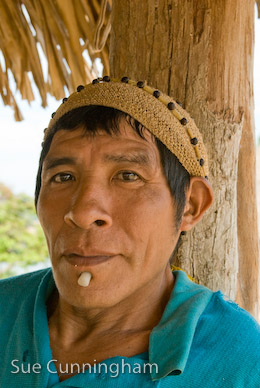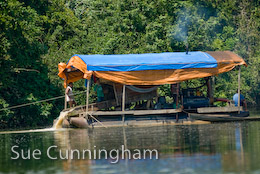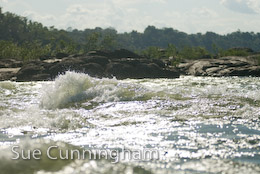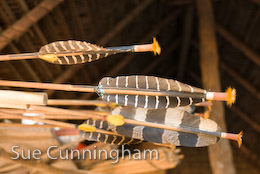 From São Félix do Xingu we moved on downriver. A long day in the Coração do Brasil took us to within a short distance of the Parakanã village of Xingu, where we made a short visit before moving on to Apyterewa, also of the Parakanã.
From São Félix do Xingu we moved on downriver. A long day in the Coração do Brasil took us to within a short distance of the Parakanã village of Xingu, where we made a short visit before moving on to Apyterewa, also of the Parakanã.
These villages lie in what is now the Apyterewa reserve. By the time the reserve was demarcated, a large part had been occupied by settlers and ranchers, and the teams doing the physical demarcation were harassed and threatened by gunmen from the ranches. The Indians today are not able to enter parts of the reserve, where they still encounter armed workers. Efforts by the authorities to remove the illegal occupants have so far been unsuccessful.
We moved on to visit the villages of the Araweté, Asurini and Arara, and the Kayapo village of Kararaô, before arriving in Altamira.
After overnighting in the town, we headed out to visit our last village, leaving Altamira at about 10 AM for a journey which our boatmen assured us would take three hours. Our plan was to return the same day.
 We passed crudely-constructed gold dredgers busily churning up the sediment of the river in their illegal quest for the yellow metal. We also saw the riverside remains of several garimpos at the side of the river.
We passed crudely-constructed gold dredgers busily churning up the sediment of the river in their illegal quest for the yellow metal. We also saw the riverside remains of several garimpos at the side of the river.
The river here is treacherous, with stretch after stretch of rock-strewn rapids. More than once the bottom of the boat scraped worryingly over the rocks. Doto, our boatman, reacted quickly to lift the outboard motor clear of the water.
 It gradually dawned on us that he was searching for the correct channel; we realised that his assurances that he knew the river were not based on fact. As more time passed, it became clear that not only did he not know the correct channel, but he didn’t have the faintest idea of the location of the village.
It gradually dawned on us that he was searching for the correct channel; we realised that his assurances that he knew the river were not based on fact. As more time passed, it became clear that not only did he not know the correct channel, but he didn’t have the faintest idea of the location of the village.
At this point the river is over 5 kilometres wide, a maze of islands, rocks, sandbanks and rapids. Our progress was slowed to a crawl. Eventually, we came across a local man in a boat, who was able to give Doto some directions; we were on the wrong side of a large island, and we had to re-trace our tracks for several kilometres – still at a crawl – and find the village from the other side.
We shot several rapids, ending up in a dead end. We returned through the swirling water, and I was ready to call a halt and return to Altamira. By now it was after 3 PM, so we were heading for an uncomfortable night somewhere, with no shelter; there was not enough time to make the return in daylight, and the rapids were too dangerous to attempt a night-time navigation.
We took one more turn, heading downstream, looking for a way to cross back to a larger channel we had left some time before. I realised that there was a full flow of water; this was still close to the bank of the river where the village lies. We followed the flow, rounded a bend – and there was the tell-tale collection of dugout canoes!
 The village bears the same name as another we also visited in the Parque Indígena Xingu; Paquissamba. Like its namesake, it is occupied by Juruna Indians; but there the similarity ends.
The village bears the same name as another we also visited in the Parque Indígena Xingu; Paquissamba. Like its namesake, it is occupied by Juruna Indians; but there the similarity ends.
These Juruna speak only Portuguese; there remain just a couple of elderly members of the community who are able to speak the Juruna language. They have lost their traditions of dance, body painting and pottery making, and they no longer keep up the tribal traditions of singing and celebrations. They live in houses more like those of their ribeirinho neighbours than those of their relatives in the Xingu Indigenous Park.
We came bearing a message from the cacique of Tuba Tuba, the largest of the traditional Juruna villages in the Parque Indígena Xingu. He sent with us a gourd vessel painted with traditional Juruna designs, the same ones they use in their body painting. He asked us to deliver an invitation to the Juruna of Pará to visit his village.
The invitation was received by Manoel, the cacique of Paquissamba, with a mixture of pleasure and shame; he was very happy to receive the invitation, but he was ashamed that he could not speak the Juruna language, that he knew none of the dances or songs. We assured him that he had no need to be ashamed, that the invitation was from the heart. He promised us that he would take up the invitation if he had the opportunity.
We stayed the night in the small village, which straggles up a hillside from the river bank, an untidy collection of wooden houses, some of which have been abandoned by inhabitants who have left to live elsewhere. The roof of the school is falling in, so the children have their lessons in an open-sided hut opposite the health post. During our visit, there was no water because of a problem with the pump from the well.
Inside the houses, the people had more material goods than we are accustomed to seeing; furniture, televisions, DVD players, sound systems, cookers, cutlery and crockery. The houses had more the feel of non-Indian houses than those found in most of the other villages we have visited.
We found the village keen to be involved in agricultural production; cacau, black pepper (pimenta do reino), and even cattle. But the village is isolated, and has little access to the materials and expertise needed to set these activities in action.
 It was in a strange way fitting that the last village we visited should be the most aligned to mainstream Brazilian culture; this was our transition back to Brazilian life.
It was in a strange way fitting that the last village we visited should be the most aligned to mainstream Brazilian culture; this was our transition back to Brazilian life.
We returned to Altamira the next day, since there are impassable waterfalls just a little further downriver. The return journey took a little over four hours, and was much less eventful than the previous day.
© Patrick Cunningham
⇒Next: Altamira to Porto de Moz
Please consider making a donation to IPCST to support our work with the indigenous people of the Xingu. Click here.




